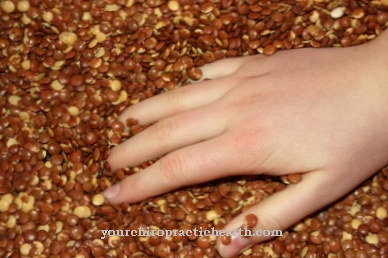At my word mutation many people probably first think of hideously defaced creatures from horror films and less of biology. Mutations play an important role everywhere in biology: for evolution, the emergence of new species, the emergence of new living beings and finally also in the emergence of many diseases. However, the mutation takes place on a much smaller level than in the movie: As a tiny change in a tiny part of our genetic make-up in just a single cell in our body. Such mutations happen thousands of times in our body all the time. So that an externally visible change emerges from a mutation, numerous coincidences really have to come together.
What is mutation?

By definition, a mutation is a permanent change in our genetic makeup, which is passed on from the mutated cell to its daughter cells as part of cell division.
By definition, is a mutation a permanent change in our genetic makeup, which is passed on from the mutated cell to its daughter cells as part of cell division.
If this mutation occurs in a sperm or egg cell in our germline, the mutation may be passed on to the offspring and we speak of a germline mutation - this creates biological diversity and permanent evolution, in the short term in the worst case also hereditary diseases.
If the mutation occurs in every other cell in the body, one speaks of a somatic mutation - in most cases this cell is dysfunctional and sorted out by the immune system, in the worst case it falls out of line, divides uncontrollably and becomes a tumor.
Functions & tasks
According to the cause, one can distinguish between spontaneous and induced mutations. Spontaneous mutations arise without any external cause and almost constantly in our body.
Countless cell divisions take place in the human organism every second, and every single time the DNA, i.e. our genetic material, has to be doubled and distributed to the two daughter cells that are created - of course, something can go wrong! Bases from the DNA can also spontaneously chemically disintegrate and one base suddenly creates another, which suddenly provides completely different information for the reading mechanisms.
Induced mutations arise through external influences and there are many suspects: The mutagenic effect is certain, for example for radiation and many so-called carcinogenic substances such as nitrosamines from cured meat or benzopyrene from cigarette smoke. Such induced mutations cannot be completely prevented in this world, but we now know a whole range of pollutants and risk factors, the avoidance of which can reduce the risk of a mutation to a minimal residue:
No smoking, no more eating burnt meat, lotion before sunbathing, only take x-rays if absolutely necessary, radiation protection at the workplace, etc. - this can prevent a large part of the mutations at cell level.
In the remaining cases, such a mutation is not that bad: a large part of our DNA is of no importance for the transmission of genetic information anyway - a mutation there does not change anything in the pattern of the proteins read. If a point of genetic information that codes for an important protein in the cell metabolism mutates, there are several protective barriers: Among other things, proteins are constantly patrolling our cells as "guardians of the genetic material", which recognize mutations and - depending on the extent - either repair them directly or, in the case of irreparability, simply initiate controlled cell death.
These cells are then simply cleared away by the immune system and new ones follow. If this protective mechanism fails and the DNA is finally read incorrectly, the result is nonsense in most cases, the cell becomes functionless and remains with its nonsense protein until it dies. Only if something "useful" happens by chance at a crucial point, i.e. something that functions in whatever way, does this sometimes have greater biological effects.
Illnesses, ailments & disorders
If the mutated cell is a germ cell, for example a sperm, and if this sperm should ultimately prevail in the race to fertilize an egg, then every smallest mutation in the genome can have major consequences: a different hair color, a Centimeters more height, different intelligence, different interests, a different person - everything is possible.
In this way, evolution has randomly tried out certain human, animal and vegetable properties from time to time, and if they proved to be good, they prevailed. Every child is not just the sum of mother and father, but also the product of small mutations, which in turn create completely new properties and keep the genetic makeup surprisingly interesting, even within the family line.
In addition, today's medicine knows a lot of defined mutations on certain genes that deviate so far from the human "normal" that they can be described as hereditary diseases: In cystic fibrosis, for example, a single gene on chromosome 7 is minimally changed - with maximum Effects on quality of life and life expectancy of those affected. In Down syndrome, on the other hand, the number of chromosomes is mutated - instead of two copies of the 21st chromosome, there are three, which is why the disease is also called trisomy 21.
There are many other examples of more serious hereditary diseases that may also spread to the offspring of the sick person. Some of them are only inherited recessively: this means that in most cases they are covered by a healthy partner chromosome and only appear as a disease when the partner chromosome has also mutated. Genetic diseases in larger families can indicate the presence of such hidden mutations and justify a visit to a human geneticist before conceiving a child.
Meanwhile, somatic mutations are more relevant for all those who are not newborns or expectant parents: If any cell in the body mutates (which, as I said, happens all the time), with a bit of luck it loses control over its cell division. This is how cancer develops. This mutation is then also irreversible and is passed on to all daughter cells, so that these also want to continue dividing infinitely without taking into account any necessities or external influences on the part of the rest of the body.
The tumor grows and grows - and will hopefully be discovered quickly enough as long as it can still be removed without major collateral damage and has not yet spread any metastases in the body.

























.jpg)


